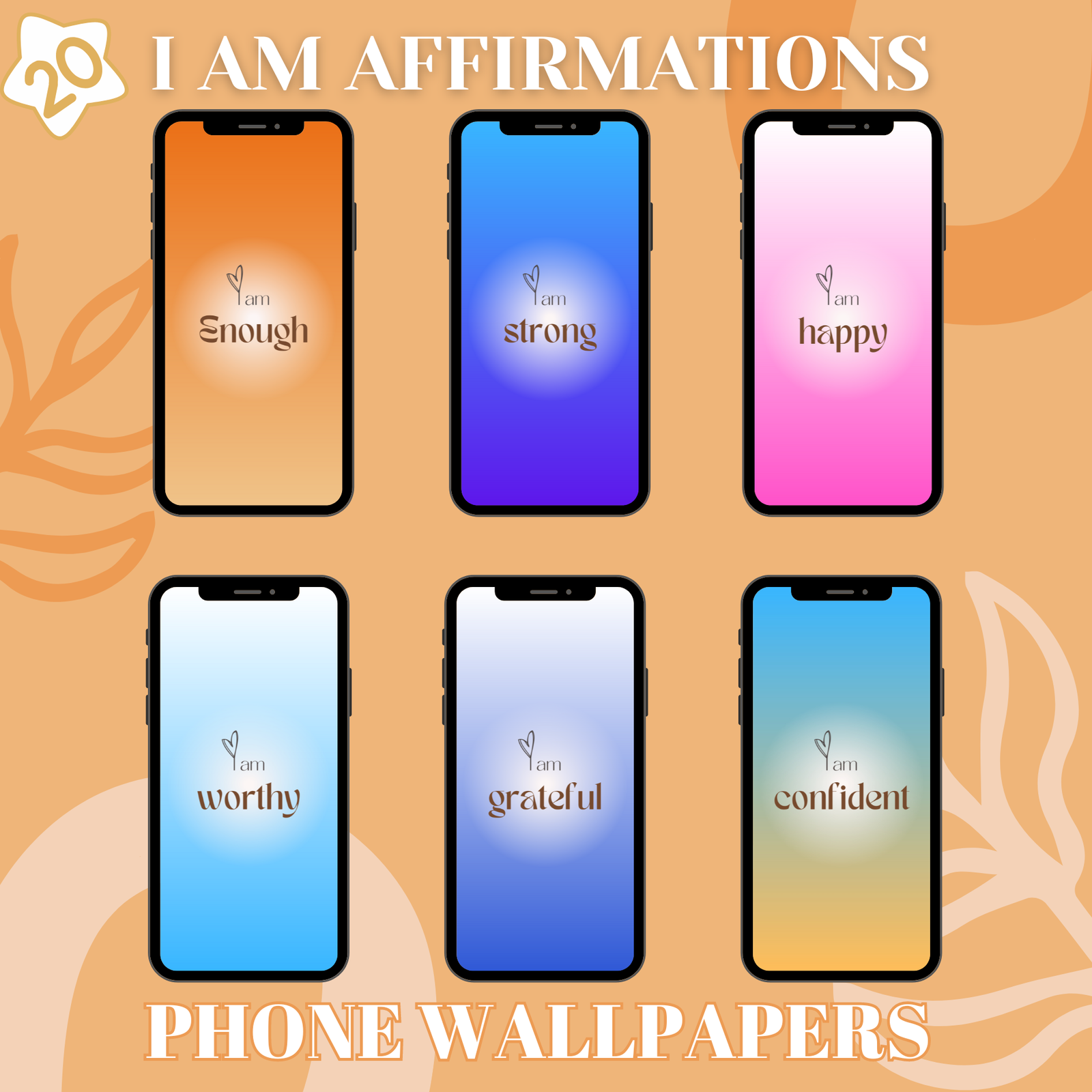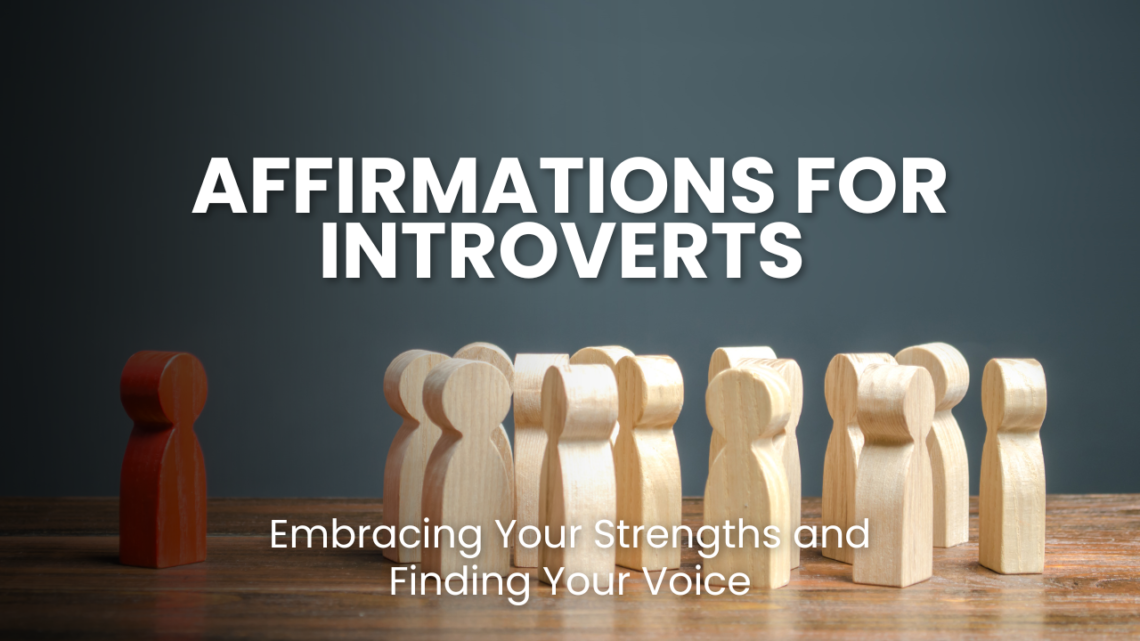In a world that often celebrates the outgoing and the vocal, it can be easy for introverts to feel misunderstood or even undervalued. However, introversion is a personality trait with its own unique set of strengths and advantages. This blog post is dedicated to introverts, offering affirmations to help you embrace your true selves, navigate a world geared towards extroversion, and find your powerful, authentic voice.
Understanding Introversion : Beyond the Basics

Introversion is often misunderstood as shyness, social anxiety, or a dislike of people. However, these are misconceptions. Introversion is fundamentally about how individuals recharge their energy. It’s about preference, not pathology.
Key Differences Between Introversion and Extroversion:
The core difference lies in how individuals gain and expend energy:
- Introverts: Gain energy from spending time alone or in quiet, less stimulating environments. Social interaction, while enjoyable in moderation, can be draining. They need downtime to recharge their “batteries.”
- Extroverts: Gain energy from social interaction and external stimulation. They thrive in busy, social environments and may feel drained or restless when alone for extended periods.
Important Distinctions:
- Introversion vs. Shyness: Shyness is characterized by a fear of social judgment and negative evaluation. Introverts may not be shy at all; they simply prefer quieter environments and smaller groups. They might enjoy socializing but need time alone afterward to recover.
- Introversion vs. Social Anxiety: Social anxiety is a clinical condition involving intense fear and anxiety in social situations. While some introverts may experience social anxiety, the two are not synonymous. Introversion is a personality trait, while social anxiety is a mental health condition.
- Introversion is a Spectrum: Just as there are varying degrees of extroversion, introversion exists on a spectrum. Some introverts are highly introverted, while others are more ambiverted (exhibiting traits of both introversion and extroversion).
- Introversion is Not Disliking People: Introverts can enjoy social interaction and value deep connections with others. They simply prefer smaller, more intimate gatherings and meaningful conversations over large, superficial ones.
The Introvert’s Brain:
Neuroscience suggests that there are differences in how introverts’ and extroverts’ brains process information and stimulation. Studies indicate that introverts tend to have:
- Increased activity in the prefrontal cortex: This area of the brain is associated with planning, decision-making, and internal thought processes. This may explain why introverts are often deep thinkers and enjoy introspection.
- Different neural pathways: Introverts tend to use longer neural pathways that involve internal processing and reflection, while extroverts tend to use shorter pathways that are more reactive to external stimuli.
- Sensitivity to Dopamine: While both introverts and extroverts experience dopamine (a neurotransmitter associated with pleasure and reward), introverts may be more sensitive to it. Excessive stimulation can lead to overstimulation and a need to withdraw.
Common Characteristics of Introverts:
While not all introverts exhibit every trait, some common characteristics include:
- Enjoying solitude: Finding pleasure and rejuvenation in spending time alone.
- Preferring deep conversations: Valuing meaningful connections and in-depth discussions over small talk.
- Being good listeners: Paying attention to others and offering thoughtful responses.
- Thinking before speaking: Processing information internally before expressing themselves verbally.
- Being observant: Noticing details and subtleties that others might miss.
- Being reflective and introspective: Spending time reflecting on their thoughts and feelings.
- Being creative and imaginative: Utilizing quiet time for creative pursuits.
- Being sensitive to overstimulation: Feeling overwhelmed by loud noises, crowds, and excessive social interaction.
The Benefits of Introversion:
Introversion is not a disadvantage; it comes with its own set of strengths and advantages:
- Deep thinking and problem-solving: Introverts’ tendency to reflect and process information thoroughly can lead to insightful solutions and innovative ideas.
- Strong listening skills: Introverts are often excellent listeners, which makes them good friends, partners, and colleagues.
- Creativity and innovation: Solitude provides fertile ground for creativity and imaginative thinking.
- Focus and concentration: Introverts can often focus deeply on tasks without being easily distracted.
- Strong sense of self: Spending time alone fosters self-awareness and a strong connection to one’s inner world.
Understanding introversion is crucial for:
- Self-acceptance: Recognizing and valuing your own personality traits.
- Improved communication: Understanding how to communicate effectively with both introverts and extroverts.
- Building stronger relationships: Appreciating the different needs and communication styles of introverts and extroverts.
- Creating supportive environments: Designing workplaces, schools, and social settings that cater to the needs of both introverts and extroverts.
By moving beyond stereotypes and understanding the true nature of introversion, we can create a more inclusive and accepting world for everyone.
The Power of Affirmations : Reshaping Your Inner World

Affirmations are more than just positive statements; they are powerful tools that can reshape your inner world, impacting your thoughts, feelings, and behaviors. They work by targeting your subconscious mind, which is responsible for your beliefs, habits, and automatic reactions.
How Affirmations Work:
- Reprogramming the Subconscious Mind: Our subconscious mind is like a vast storage bank of past experiences, beliefs, and memories. Often, this storage bank contains negative or limiting beliefs that hold us back. Affirmations act as a form of “reprogramming,” replacing these negative beliefs with positive, empowering ones.
- Neuroplasticity: The brain is not static; it’s constantly changing and adapting through a process called neuroplasticity. Repeating affirmations creates new neural pathways in the brain, strengthening positive thought patterns and weakening negative ones.
- Shifting Your Focus: Affirmations direct your attention towards positive possibilities and desired outcomes. By focusing on what you want to achieve or the qualities you want to cultivate, you are more likely to take actions that align with those goals.
- Boosting Self-Efficacy: Self-efficacy is the belief in your ability to succeed in specific situations or accomplish tasks. Affirmations can boost self-efficacy by reinforcing your strengths, skills, and potential.
- Reducing Stress and Anxiety: When faced with challenges or stressful situations, negative self-talk can exacerbate feelings of anxiety and overwhelm. Affirmations can counteract this negative self-talk, promoting a sense of calm and control.
The Science Behind Affirmations:
While the concept of affirmations may seem simple, there is growing scientific evidence supporting their effectiveness:
- Studies on Self-Affirmation: Research has shown that self-affirmation (affirming one’s values and self-worth) can reduce defensiveness, increase openness to new information, and improve problem-solving abilities.
- Brain Imaging Studies: Neuroimaging studies have shown that practicing affirmations can activate certain areas of the brain associated with self-related processing and reward, suggesting that affirmations have a tangible impact on brain activity.
- Impact on Behavior: Studies have also demonstrated that affirmations can influence behavior, leading to increased academic performance, improved health behaviors, and greater resilience in the face of challenges.
Key Elements of Effective Affirmations:
To maximize the power of affirmations, it’s important to craft them effectively:
- Present Tense: Frame your affirmations in the present tense, as if you have already achieved the desired outcome. For example, instead of saying “I will be confident,” say “I am confident.”
- Positive Language: Use positive language and avoid negative words like “not,” “don’t,” or “can’t.” Focus on what you want to achieve, not what you want to avoid.
- Personal and Specific: Make your affirmations personal and specific to your needs and goals. The more relevant and meaningful they are to you, the more impact they will have.
- Emotionally Engaging: Connect with the emotions behind your affirmations. Feel the feelings of confidence, joy, or gratitude as you repeat them.
- Believable and Realistic: While it’s important to aim high, your affirmations should also be believable and realistic. Start with affirmations that you can genuinely connect with and gradually expand your beliefs as you progress.
Examples of Affirmations for Different Areas of Life:
- Self-Esteem: “I am worthy of love and respect.” “I value my unique qualities and strengths.”
- Confidence: “I am confident in my abilities.” “I embrace challenges and opportunities for growth.”
- Success: “I am capable of achieving my goals.” “I am open to new possibilities and opportunities.”
- Health: “I am healthy and vibrant.” “I nourish my body and mind with positive energy.”
- Relationships: “I attract loving and supportive relationships.” “I communicate effectively and build strong connections.”
Integrating Affirmations into Your Daily Routine:
- Morning Ritual: Start your day by reciting your affirmations to set a positive tone for the day ahead.
- Throughout the Day: Repeat your affirmations whenever you feel stressed, anxious, or need a boost of confidence.
- Before Bed: Review your affirmations before going to sleep to allow them to sink into your subconscious mind overnight.
- Journaling: Write your affirmations in a journal to reinforce them and track your progress.
- Visualization: Combine affirmations with visualization techniques to create a powerful mental image of your desired outcome.
Cautions and Considerations:
- Consistency is Key: Affirmations are most effective when practiced consistently over time. It takes time and repetition to reprogram the subconscious mind.
- Combine with Action: Affirmations are not a magic bullet. They work best when combined with action and effort towards your goals.
- Address Underlying Issues: If you are struggling with deep-seated negative beliefs or mental health challenges, it’s important to seek professional help in addition to using affirmations.
Affirmations for Embracing Your Introverted Strengths



Here are some affirmations tailored specifically for introverts:
- “My introversion is a strength, not a weakness.” This affirmation helps you reframe your perception of introversion, recognizing it as a valuable part of who you are.
- “I am a deep thinker with valuable insights.” Introverts often excel at deep thought and reflection. This affirmation acknowledges and celebrates this strength.
- “My quiet presence is powerful.” You don’t need to be loud to make an impact. This affirmation reminds you that your presence is felt and valued, even in silence.
- “I trust my intuition and inner wisdom.” Introverts often have strong intuition. This affirmation encourages you to trust your gut feelings and inner voice.
- “I am a good listener and offer thoughtful perspectives.” Introverts are often excellent listeners, providing considered and valuable input when they do speak.
- “I value deep connections over superficial interactions.” This affirmation validates your preference for meaningful conversations and close relationships.
- “I am creative and innovative.” The quiet time that introverts cherish can be a breeding ground for creativity and innovation.
- “I am comfortable in my own company.” This affirmation celebrates your ability to enjoy solitude and find contentment within yourself.
- “I recharge and rejuvenate through quiet time.” This affirmation reinforces the importance of self-care and honoring your need for downtime.
Affirmations for Navigating an Extroverted World
While embracing your introversion is essential, it’s also important to be able to navigate a world that often favors extroversion. These affirmations can help:
- “I can confidently express my thoughts and ideas when I choose to.” This affirmation empowers you to speak up when you feel it’s important, without feeling pressured to be constantly vocal.
- “I set healthy boundaries to protect my energy.” This affirmation reminds you that it’s okay to say no to social engagements when you need to recharge.
- “I can handle social situations with grace and confidence.” This affirmation helps you approach social interactions with a sense of calm and self-assurance.
- “I am capable of connecting with others in meaningful ways.” This affirmation reinforces your ability to build strong relationships, even if you do so in a quieter way.
- “I embrace opportunities for growth outside my comfort zone.” This affirmation encourages you to step outside your comfort zone while still honoring your need for balance.
- “I am resilient and adaptable.” This affirmation reminds you of your ability to navigate different social situations and environments.
- “I give myself permission to take breaks and recharge when needed.” This affirmation reinforces the importance of self-care, even in the midst of social activities.
- “I am worthy of respect and understanding, just as I am.” This affirmation promotes self-acceptance and encourages you to expect others to respect your needs.



Using Affirmations Effectively : A Practical Guide

While the concept of affirmations is simple, their effectiveness hinges on how they are implemented. Here’s a comprehensive guide to help you use affirmations effectively:
1. Choosing the Right Affirmations:
- Identify Your Needs: Start by identifying the specific areas of your life where you want to see improvement. Are you struggling with self-esteem, confidence, anxiety, or achieving specific goals?
- Target Specific Challenges: Choose affirmations that directly address your specific challenges. If you struggle with social anxiety, an affirmation like “I am calm and confident in social situations” would be more effective than a general affirmation like “I am happy.”
- Make Them Personal: Tailor affirmations to your own experiences and beliefs. The more personal and relevant they are, the more likely you are to connect with them on an emotional level.
- Focus on the Positive: Frame affirmations in positive language, focusing on what you want to achieve rather than what you want to avoid. Avoid using negative words like “no,” “not,” or “don’t.” For example, instead of “I will not be afraid,” say “I am courageous.”
- Use Present Tense: Phrase your affirmations as if they are already true. This helps to impress the subconscious mind and create a sense of certainty. Instead of “I will be successful,” say “I am successful.”
- Keep Them Concise: Short, memorable affirmations are easier to repeat and internalize. Aim for affirmations that are clear, concise, and easy to recall.
- Believe in Them (or at Least Be Open to the Possibility): While you don’t necessarily need to fully believe your affirmations at first, it’s important to be open to the possibility that they could be true. Start with affirmations that feel believable or at least plausible to you, and gradually expand your belief system as you progress.
2. Crafting Powerful Affirmations:
- Use “I Am” Statements: Starting your affirmations with “I am” is a powerful way to assert your desired state of being.
- Add Feeling and Emotion: Connect with the emotions associated with your affirmations. Visualize yourself experiencing the desired outcome and feel the corresponding emotions.
- Use Sensory Language: Incorporate sensory details into your affirmations to make them more vivid and impactful. For example, “I feel the warm sun on my skin as I confidently present my ideas.”
- Combine with Visualization: Visualize yourself already living the affirmation. This strengthens the message and makes it more real to your subconscious mind.
3. Implementing Affirmations into Your Daily Routine:
- Morning Ritual: Start your day by reciting your affirmations. This sets a positive tone for the day and programs your mind for success.
- Throughout the Day: Repeat your affirmations throughout the day, especially during moments of stress, self-doubt, or when facing challenges.
- Before Bed: Review your affirmations before going to sleep. This allows them to sink into your subconscious mind overnight.
- Written Affirmations: Write your affirmations in a journal or on sticky notes and place them where you will see them frequently.
- Record Your Affirmations: Record yourself speaking your affirmations and listen to the recording regularly.
- Affirmation Cards: Create affirmation cards and carry them with you. Review them during breaks or whenever you need a boost of positivity.
- Mirror Work: Look yourself in the eye in a mirror and recite your affirmations. This can be a powerful way to connect with your inner self.
4. Maintaining Consistency and Patience:
- Regular Practice: Consistency is key to the effectiveness of affirmations. Make it a daily habit to repeat your affirmations, even if you don’t feel immediate results.
- Repetition: Repeat your affirmations multiple times during each session. The more you repeat them, the stronger the message becomes.
- Patience and Persistence: It takes time for affirmations to reprogram the subconscious mind. Be patient and persistent, and don’t get discouraged if you don’t see results immediately.
- Track Your Progress: Keep a journal or track your progress in some way. This can help you stay motivated and see the positive changes that are occurring.
5. Overcoming Challenges:
- Resistance and Doubt: It’s common to experience resistance or doubt when starting to use affirmations. Acknowledge these feelings but don’t let them stop you from practicing.
- Negative Self-Talk: Pay attention to your negative self-talk and consciously replace negative thoughts with your affirmations.
- Inconsistency: If you find it difficult to maintain consistency, try setting reminders or incorporating affirmations into existing routines.
6. Combining Affirmations with Other Practices:
- Meditation: Combine affirmations with meditation to deepen their impact and create a sense of calm and focus.
- Visualization: Use visualization techniques to create a vivid mental image of your desired outcome while repeating your affirmations.
- Gratitude Practice: Combine affirmations with a gratitude practice to cultivate a positive and appreciative mindset.
- Action and Effort: Remember that affirmations are most effective when combined with action and effort towards your goals.
Finding Your Voice

Finding your voice as an introvert is about more than just speaking up in a crowded room; it’s about connecting with your authentic self and expressing it in ways that feel genuine and comfortable for you. It’s about recognizing that your quiet strength and thoughtful insights are valuable assets.
Here’s a breakdown of what finding your voice truly means for introverts:
- Embracing Authenticity: It’s about aligning your outer expression with your inner world. This means honoring your need for solitude, valuing deep connections, and expressing yourself in ways that feel genuine, whether it’s through writing, creative pursuits, or thoughtful one-on-one conversations.
- Recognizing Your Value: Understanding that your unique perspective, careful observations, and considered opinions are valuable contributions. It’s about silencing the inner critic that might tell you your thoughts aren’t important or that you need to be louder to be heard.
- Communicating Effectively: Learning to communicate in ways that leverage your strengths. This might involve preparing beforehand, choosing smaller settings for discussions, or utilizing written communication to express complex ideas.
- Setting Boundaries: Protecting your energy by setting healthy boundaries. This means knowing when to say no to social engagements, prioritizing downtime, and creating space for reflection and recharge.
- Expressing Your Creativity: Finding outlets for your inner world through creative pursuits like writing, art, music, or any activity that allows you to express your unique perspective and insights.
- Advocating for Yourself: Confidently expressing your needs and preferences, whether it’s asking for a quiet workspace, requesting time to process information before making a decision, or simply stating your need for a break from social interaction.
Finding your voice is a journey of self-discovery and empowerment. It’s about embracing your introversion, recognizing your unique strengths, and expressing yourself in ways that feel authentic and meaningful to you.
Embracing the Power of Introversion : A Path to Authentic Living
The journey through understanding introversion, utilizing affirmations, and finding your voice culminates in a powerful conclusion: embracing the inherent strengths and unique advantages that come with being an introvert. It’s about shifting from a perspective of perceived deficit to one of deep appreciation for your inherent qualities.
Embracing the power of introversion means:
- Self-Acceptance and Self-Compassion: At its core, embracing introversion is about accepting yourself fully, with all your unique traits and tendencies. It’s about letting go of the pressure to conform to extroverted ideals and cultivating self-compassion for your needs and preferences. This means acknowledging your need for solitude without guilt, valuing your deep thinking without feeling inadequate for not being constantly vocal, and honoring your sensitivity to stimulation without shame.
- Recognizing the Value of Quiet Strength: Introverts often possess a quiet strength that is often overlooked in a world that prioritizes outward displays of energy. This strength manifests in various ways: deep concentration, thoughtful analysis, careful observation, empathetic listening, and a strong inner compass. Embracing this quiet strength means recognizing its power and leveraging it to your advantage.
- Harnessing Inner Resources: Introverts have rich inner worlds filled with thoughts, reflections, and creative potential. Embracing introversion means tapping into these inner resources and utilizing them for personal growth, creativity, and problem-solving. It’s about valuing the time spent in introspection and using it to gain deeper insights into yourself and the world around you.
- Cultivating Meaningful Connections: While introverts may not thrive in large, superficial social settings, they excel at building deep, meaningful connections with others. Embracing introversion means prioritizing quality over quantity in your relationships and nurturing the bonds that truly resonate with you.
- Living Authentically: Embracing introversion allows you to live a more authentic life, aligned with your true self. This means making choices that honor your needs and preferences, whether it’s choosing a career that allows for focused work, setting healthy boundaries in social situations, or simply prioritizing downtime for recharge.
- Contributing Unique Perspectives: The world needs the unique perspectives and contributions of introverts. Your thoughtful insights, careful analysis, and creative ideas are valuable assets. Embracing introversion means finding ways to share your gifts with the world in ways that feel authentic and comfortable for you.
- Thriving in a Balanced Way: Embracing introversion isn’t about isolating yourself or avoiding all social interaction. It’s about finding a balance between your need for solitude and your desire for connection. It’s about creating a lifestyle that supports your well-being and allows you to thrive in all aspects of your life.
Ultimately, embracing the power of introversion is about recognizing that it’s not a limitation but a source of strength. It’s about celebrating your unique qualities, honoring your needs, and living a life that is authentic, fulfilling, and deeply meaningful. It’s about understanding that your quiet strength is a superpower, and the world needs it.
Enhance Your Journey with These Empowering Tools
As you embrace change and navigate life’s transitions with the help of affirmations, it’s important to equip yourself with tools that support your growth and well-being. From affirmation card decks to self-care essentials, the right products can help reinforce your positive mindset and create a nurturing environment for personal transformation.
Below are some carefully selected items that can complement your affirmation practice, making it easier to stay focused, resilient, and mindful throughout your journey :
- 30.48 cm 15-Note Steel Tongue Drum D Key Percussion Instrument Cornices Shape Handpan Drum With Drum Mallets Carry Bag And Music Book, Used For Music Education Concert Spiritual Healing Yoga Entertainment 👉 item link
- Messages of Life Inspiration Cards – 44-Card Deck with Guidebook for Positive Affirmations & Spiritual Growth, Durable Paper Material, Ideal for Ages 14 & Up – Motivational Oracle Card Game 👉 item link
- Deck of Emotions Playing Cards – 54 Card Set for Mental Health, Family Bonding, Party Fun – Christmas, Halloween, Easter, Hanukkah, Thanksgiving – Ideal Gift for Birthday, Aesthetic Home Decor – Paper Material, No Electricity Needed 👉 item link
- 1pc Self-Care English Cover Star Moon Multicolored Optional Record 5 Minutes A Day, For Learning Supplies, Notebook, Library, More Affirmations Reflections, Optimistic, Happy, Simple Undated Hardcover 👉 item link
- 3pcs Wooden Framed Canvas Poster, Modern Art, Inspirational Canvas Painting, Ideal Gift For Bedroom Living Room Corridor, Wall Art, Wall Decor, Winter Decor, Room Decoration 👉 item link








